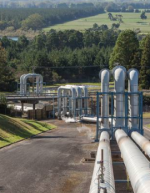Taupō is home to the country's biggest lake, great trout fishing and - now - innovative, sustainable lithium extraction technology.
The Government recently announced Ohaaki-based company Geo40 would get $2 million of funding from the Regional Economic Development and Investment Unit, Kānoa, to scale up its lithium operations.
So what makes Geo40's process so revolutionary, what's hot about lithium and what does it mean for the wider region?
Why is lithium such a hot commodity?
Geo40 chief executive John Worth says the green revolution, especially the push for electric cars, has catapulted the mineral into high demand.
"Lithium has become one of the base minerals for battery technology," he said.
"The price has, for quite some time, been around that US$10,000 [per tonne] (NZD$15,000). But because of supply shortages, we're seeing extraordinary spot prices, especially the Chinese spot price, where that's now reached $50,000 a tonne for the first time."
What's different about Geo40's operation?
Traditional ways of mining lithium are environmentally damaging.
Every tonne of lithium extracted through hard rock mining generates about 15,000 tonnes of carbon dioxide.
Lithium can also be extracted from brine, which is an extremely salty liquid that sits underground. The brine is pumped up to the surface into big ponds and left for a couple of years for the water to evaporate, leaving behind lithium salts.
That uses two million litres of water for every tonne of lithium produced.
But Geo40's method is different and they've already tried it with another compound – silica, which is used for things like densification of concrete and cement.
The company extracts the fluid from underground, separates the minerals from the water and then returns the fluid back - sometimes even using waste fluid from the geothermal power plant. Worth says they only emit about 200kg of carbon dioxide per tonne of silica.
"We are the first company on the planet to get colloidal silica out of geothermal fluid at scale," Worth said.
The company is using a similar process for lithium and will complete a life cycle assessment of the mineral's carbon footprint soon.
Is this a game changer for Taupō's economy?
Taupō mayor David Trewavas thinks so.
He says Covid-19 is beginning to hit the region hard.
"For the financial year of 2021, up until last December, we were absolutely in boom time," he said.
"But just in the last couple of months, I can feel it in the air - things are starting to come to a bit of a grinding halt."
Trewavas says Geo40 is making a "wonderful product" and it's bringing highly skilled professionals into the area as well.
"We've got international scientists there, 40 odd staff on-site and luckily they've got the pay bracket to go with it and the downflow effect, most of them buy local."
Economic and Regional Development Minister Stuart Nash was at the Ohaaki Power Station last month where he announced the Government will invest $2 million from its new Regional Strategic Partnership Fund (RSPF) in Geo40 Limited, to help scale up its lithium recovery technology.
Nash says the technology has the potential to strengthen New Zealand's geothermal energy and advanced manufacturing sectors and contribute to a lower-carbon future.
"This is a game-changing programme of work.
"The investment is the first by the RSPF. It delivers on a manifesto commitment to keep supporting regional economic development once the Provincial Growth Fund closed to applications. Regional leaders help set the strategic priorities for RSPF investment, which is seed funding as a catalyst for other investment."
Nash says EVs are expected to account for more than half of new car sales in the Northern Hemisphere by 2030.
"Overseas, traditional ways of mining lithium leave a heavy carbon footprint. In contrast, the Geo40 programme involves new technology to sustainably recover lithium from geothermal brine, and return the water to the geothermal field. The brine is a watery residue containing mineral compounds and is a byproduct of geothermal electricity generation.
"If we can successfully build up Geo40's green technology to commercial scale, New Zealand could become an international leader in technology for the sustainable supply of lithium, and help to build lasting action on climate change."
Credit: NZHerald.co.nz

